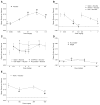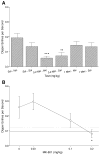An examination of NMDA receptor contribution to conditioned responding evoked by the conditional stimulus effects of nicotine
- PMID: 20859617
- PMCID: PMC3028533
- DOI: 10.1007/s00213-010-2022-5
An examination of NMDA receptor contribution to conditioned responding evoked by the conditional stimulus effects of nicotine
Abstract
Rationale: Research using a drug discriminated goal-tracking (DGT) task showed that the N-methyl-D: -aspartate (NMDA) channel blocker MK-801 (dizocilpine) reduced the nicotine-evoked conditioned response (CR).
Objectives: Given the unknown mechanism of the effect, Experiment 1 replicated the MK-801 results and included tests with NMDA receptor ligands. Experiments 2a and 2b tested whether MK-801 pretreatment blocked DGT via a state-dependency effect.
Methods: In Experiment 1, adult male Sprague-Dawley rats received intermittent access to liquid sucrose following nicotine (0.4 mg base/kg); no sucrose was delivered on intermixed saline sessions. Conditioning was indicated by increased anticipatory dipper entries (goal-tracking) on nicotine compared to saline sessions. Antagonism and/or substitution tests were conducted with MK-801, phencyclidine, CGP 39551, d-CPPene (SDZ EAA 494), Ro 25,6981, L-701,324, ACPC, and NMDA. In Experiment 2a, rats received nicotine and sucrose on every session-no intermixed saline sessions without sucrose. Tests combined MK-801 or the non-competitive nicotinic acetylcholine receptor antagonist, mecamylamine with either nicotine or saline. Experiment 2b had sucrose delivered on saline sessions and no sucrose on intermixed nicotine sessions followed by MK-801 antagonism tests of the saline CS.
Results: MK-801 and phencyclidine dose-dependently attenuated the CR in Experiment 1. Ro-25,6981 enhanced the CR, but did not substitute for nicotine. Other ligands showed inconsistent effects. In Experiment 2a, MK-801 pretreatment reduced goal-tracking when given before nicotine and saline test sessions; mecamylamine pretreatment had no effect. In Experiment 2b, MK-801 dose-dependently attenuated the saline-evoked CR.
Conclusions: Combined, the results suggest that MK-801 blocks discriminated goal-tracking by virtue of state-changing properties.
Figures


Similar articles
-
Drug discrimination analysis of NMDA receptor channel blockers as nicotinic receptor antagonists in rats.Psychopharmacology (Berl). 2005 Apr;179(1):128-35. doi: 10.1007/s00213-004-2067-4. Epub 2005 Jan 29. Psychopharmacology (Berl). 2005. PMID: 15682308
-
Lowered brain stimulation reward thresholds in rats treated with a combination of caffeine and N-methyl-D-aspartate but not alpha-amino-3-hydroxy-5-methyl-4-isoxazole propionate or metabotropic glutamate receptor-5 receptor antagonists.Behav Pharmacol. 2006 Jun;17(4):295-302. doi: 10.1097/01.fbp.0000205014.67079.be. Behav Pharmacol. 2006. PMID: 16914947
-
Behavioral and neuropharmacological characterization of nicotine as a conditional stimulus.Eur J Pharmacol. 2007 Apr 30;561(1-3):91-104. doi: 10.1016/j.ejphar.2007.01.046. Epub 2007 Feb 1. Eur J Pharmacol. 2007. PMID: 17343849 Free PMC article.
-
Characterization of nicotine's ability to serve as a negative feature in a Pavlovian appetitive conditioning task in rats.Psychopharmacology (Berl). 2006 Mar;184(3-4):470-81. doi: 10.1007/s00213-005-0079-3. Epub 2005 Jul 27. Psychopharmacology (Berl). 2006. PMID: 16047193
-
Postnatal lead exposure and MK-801 sensitivity.Neurotoxicology. 1997;18(1):209-20. Neurotoxicology. 1997. PMID: 9216003
Cited by
-
The effect of sazetidine-A and other nicotinic ligands on nicotine controlled goal-tracking in female and male rats.Neuropharmacology. 2017 Feb;113(Pt A):354-366. doi: 10.1016/j.neuropharm.2016.10.014. Epub 2016 Oct 17. Neuropharmacology. 2017. PMID: 27765626 Free PMC article.
-
Conditioned response evoked by nicotine conditioned stimulus preferentially induces c-Fos expression in medial regions of caudate-putamen.Neuropsychopharmacology. 2012 Mar;37(4):876-84. doi: 10.1038/npp.2011.263. Epub 2011 Nov 2. Neuropsychopharmacology. 2012. PMID: 22048468 Free PMC article.
-
Nicotine trained as a negative feature passes the retardation-of-acquisition and summation tests of a conditioned inhibitor.Learn Mem. 2011 Jun 21;18(7):452-8. doi: 10.1101/lm.2177411. Print 2011. Learn Mem. 2011. PMID: 21693633 Free PMC article.
-
Disentangling the nature of the nicotine stimulus.Behav Processes. 2012 May;90(1):28-33. doi: 10.1016/j.beproc.2011.10.020. Epub 2011 Nov 24. Behav Processes. 2012. PMID: 22119845 Free PMC article. Review.
References
-
- Besheer J, Palmatier MI, Metschke DM, Bevins RA. Nicotine as a signal for the presence or absence of sucrose reward: a Pavlovian drug appetitive conditioning preparation in rats. Psychopharmacology. 2004;172:108–117. - PubMed
-
- Bevins RA, Palmatier MI. Extending the role of associative learning processes in nicotine addiction. Behav Cog Neurosci Rev. 2004;3:143–158. - PubMed
-
- Bevins RA, Besheer J, Pickett KS. Nicotine-conditioned locomotor activity in rats: dopaminergic and GABAergic influences on conditioned expression. Pharmacol Biochem Behav. 2001;68:135–145. - PubMed
Publication types
MeSH terms
Substances
Grants and funding
LinkOut - more resources
Full Text Sources
Research Materials

